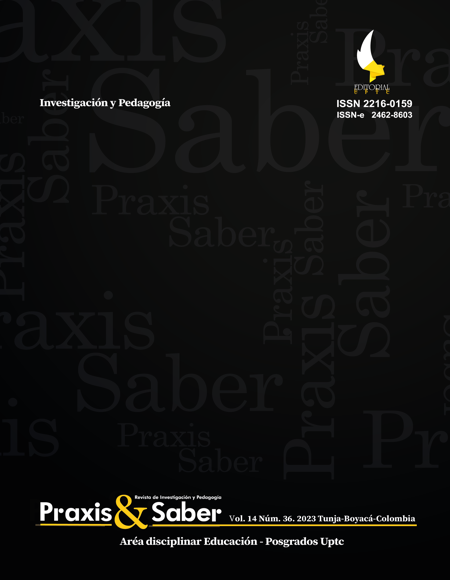Jorba and Sanmartí’s Scaffolding and Learning Cycle: Convergence and Application in Mathematical Education

Abstract
Although Jorba and Sanmartí's scaffolding and learning cycle have accumulated several
decades of research, no study has performed a conjoint analysis of both methods. Based on their
theoretical approaches, this paper presents a conceptual model for their convergence. This link
made it possible to design and implement a didactic sequence contextualized for the teaching
of rational numbers in rural schools. A novel metacognitive evaluation card was constructed in
order to integrate convergence, the teacher’s role, and the expected student performances. The
worksheet facilitated the results and revealed, from an empirical and descriptive perspective,
that the proposed convergence is effective because it favored the understanding of the content,
promoted student’s; autonomy, and significantly impacted their affectivity. However, the gradual
withdrawal of the teacher’s support and the increasing complexity of the activities caused a
progressive decrease in the student’s; performances. The proposed conjunction adapts well to
the rural school learning context and is expected to be attractive for combining both cognitive
and socio-affective interests.
Keywords
scaffolding, Jorba and Sanmartí’s learning cycle, rural context, mathematical education
References
- Álvarez, R., Fernández, H., & Rúa, J. (2009). Matemáticas básicas con aplicaciones. Ecoe ediciones.
- Bakker, A., Smit, J., & Wegerif, R. (2015). Scaffolding and dialogic teaching in mathematics education: introduction and review. ZDM Mathematics Education, 47, 1047-1065. https://doi.org/10.1007/s11858-015-0738-8 DOI: https://doi.org/10.1007/s11858-015-0738-8
- Bernal, M., y Martínez, M. (2017). Metodologías activas para la enseñanza y el aprendizaje. Revista Panamericana de Pedagogía, (25), 270-275. https://doi.org/10.21555/rpp.v0i25.1695 DOI: https://doi.org/10.21555/rpp.v0i25.1695
- Bieg, M., Goetz, T., Sticca, F., Brunner, E., Becker, E., Morger, V., & Hubbard, K. (2017). Teaching methods and their impact on students’ emotions in mathematics: an experience-sampling approach. ZDM Mathematics Education, 49, 411-422.
- https://doi.org/10.1007/s11858-017-0840-1 DOI: https://doi.org/10.1007/s11858-017-0840-1
- Castillo, M. (2011). La socioafectividad en la educación desde la complejidad. Educación y Humanismo, 13(21), 129-146. https://revistas.unisimon.edu.co/index.php/educacion/article/view/2267
- Cevikbas, M., & Kaiser, G. (2022). Student Engagement in a Flipped Secondary Mathematics Classroom. International Journal of Science and Mathematics Education, 20, 1455-1480. https://doi.org/10.1007/s10763-021-10213-x DOI: https://doi.org/10.1007/s10763-021-10213-x
- Clark, L., & Watson, D. (2019). Constructing validity: New developments in creating objective measuring instruments. Psychological Assessment, 31(12), 1412-1427. https://doi.org/10.1037/pas0000626 DOI: https://doi.org/10.1037/pas0000626
- Crujeiras, B., y Jiménez, M. (2018). Influencia de distintas estrategias de andamiaje para promover la participación del alumnado de secundaria en las prácticas científicas. Enseñanza de las ciencias, 36(2), 23-42. https://doi.org/10.5565/rev/ensciencias.2241 DOI: https://doi.org/10.5565/rev/ensciencias.2241
- de Arriba, R., y Paredes-Velasco, M. (2021, octubre 20-22). Aplicación de andamiaje en un modelo de aprendizaje sostenible y su influencia en el estado emocional durante la COVID-19 [Conferencia]. VI Congreso Internacional sobre Aprendizaje, Innovación y Cooperación (CINAIC 2021), Madrid, España. https://zaguan.unizar.es/record/107739/files/036.pdf
- DOI: 10.26754/CINAIC.2021.0036 DOI: https://doi.org/10.26754/CINAIC.2021.0036
- Elias, H., Ribeiro, A., & Savioli, A. (2020). Epistemological Matrix of Rational Number: a Look at the Different Meanings of Rational Numbers. International Journal of Science and Mathematics Education, 18, 357-376. https://doi.org/10.1007/s10763-019-09965-4 DOI: https://doi.org/10.1007/s10763-019-09965-4
- Fernández-Lasarte, O., Ramos-Díaz, E., Goñi, E., y Rodríguez-Fernández, A. (2019). Estudio comparativo entre educación superior y educación secundaria: efecto del apoyo social percibido, el autoconcepto y la reparación emocional en el rendimiento académico. Educación XX1, 22(2), 165-185. https://doi.org/10.5944/educXX1.22526 DOI: https://doi.org/10.5944/educxx1.22526
- Gómez, J., Hernández, H., & Hernández, V. (2021). Scaffolding system for solving problems in engineering education. Revista Ingenierías Universidad De Medellín, 20(39), 35-53. https://doi.org/10.22395/rium.v20n39a2 DOI: https://doi.org/10.22395/rium.v20n39a2
- Hernández-Sampieri, R., y Mendoza, C. (2018). Metodología de la investigación. Las rutas cuantitativa, cualitativa y mixta. Mc Graw Hill.
- Jorba, J., y Sanmartí, N. (1996). Enseñar, aprender y evaluar: un proceso de evaluación continua. Propuesta didáctica para las áreas de las ciencias de la naturaleza y matemáticas. Ministerio de Educación y Cultura.
- Kieren, T. (1976). On the mathematical, cognitive, and instructional foundations of rational numbers. En: Lesh, R. (ed.). Number and measurement: Papers from a research workshop, 101-144. Columbus. https://files.eric.ed.gov/fulltext/ED120027.pdf
- Kusmaryono, I., & Wijayanti, D. (2020). Tinjauan sistematis: strategis scaffolding pada pembelajaran matematika. Phenomenon: Jurnal Pendidikan MIPA, 10(1), 102-117. https://doi.org/10.21580/phen.2020.10.1.6114 DOI: https://doi.org/10.21580/phen.2020.10.1.6114
- López, O., Sanabria, L., y Buitrago, N. (2018). Efecto diferencial de un andamiaje metacognitivo sobre la autorregulación y el logro de aprendizaje en un ambiente combinado. Tecné, Episteme y Didaxis: TED, (44), 33-50. https://doi.org/10.17227/ted.num44-8988 DOI: https://doi.org/10.17227/ted.num44-8988
- Masinading, Z., & Gaylo, D. (2022). Differentiated Scaffolding Strategies in Triangle Congruence: Their Effects on Learners’ Academic Performance and Confidence in Mathematics. International Journal of Education and Literacy Studies, 10(2), 131-140. https://doi.org/10.7575/aiac.ijels.v.10n.2p.131 DOI: https://doi.org/10.7575/aiac.ijels.v.10n.2p.131
- Matas, A. (2018). Diseño del formato de escalas tipo Likert: un estado de la cuestión.
- Revista Electrónica de Investigación Educativa, 20(1), 38-47. https://doi.org/10.24320/redie.2018.20.1.1347 DOI: https://doi.org/10.24320/redie.2018.20.1.1347
- Park, S., & Esposito, A. (2022). Rational number conceptualization predicts mathematics achievement: Quantity matters. Cognitive Development, 63, 101195. https://doi.org/10.1016/j.cogdev.2022.101195 DOI: https://doi.org/10.1016/j.cogdev.2022.101195
- Reynolds, D. (2017). Interactional Scaffolding for Reading Comprehension: A Systematic Review. Literacy Research: Theory, Method, and Practice, 66(1),135-156. https://doi.org/10.1177/2381336917718820 DOI: https://doi.org/10.1177/2381336917718820
- Romero, Y., Tuay, R., y Pérez, M. (2021). Relación emociones y educación en ciencias: estado del arte reportado en eventos académicos. Praxis & Saber, 12(28), e11173. https://doi.org/10.19053/22160159.v12.n28.2021.11173 DOI: https://doi.org/10.19053/22160159.v12.n28.2021.11173
- Sandín, M. (2003). Investigación Cualitativa en Educación. Fundamentos y tradiciones. Mc Graw Hill.
- Sanmartí, N. (2005). La unidad didáctica en el paradigma constructivista. En: Couso, D. et al. (eds.). Unidades didácticas en ciencias y matemáticas. Capítulo 1, 13-58. Editorial Magisterio.
- Sommer, M., y Cabello, V. (2020). Andamios de retiro gradual. Parte 2: Apoyos a la construcción de explicaciones en ciencia primaria. Estudios pedagógicos, 46(1), 269-284. http://dx.doi.org/10.4067/S0718-07052020000100269 DOI: https://doi.org/10.4067/S0718-07052020000100269
- van de Pol, J., Volman, M., & Beishuizen, J. (2010). Scaffolding in Teacher–Student Interaction: A Decade of Research. Educational Psychology Review, 22, 271-296. https://doi.org/10.1007/s10648-010-9127-6 DOI: https://doi.org/10.1007/s10648-010-9127-6
- Wood, D., Bruner, J., & Ross, G. (1976). The role of tutoring in problem solving. Journal of Child Psychology and Psychiatry and Allied Disciplines, 17, 89-100. https://doi.org/10.1111/j.1469-7610.1976.tb00381.x DOI: https://doi.org/10.1111/j.1469-7610.1976.tb00381.x
- Wright, V. (2018). Vygotsky and a Global Perspective on Scaffolding in Learning Mathematics. En: Zajda, J. (ed.). Globalisation and Education Reforms. Capítulo 8, 123-135. Springer. https://doi.org/10.1007/978-94-024-1204-8_8 DOI: https://doi.org/10.1007/978-94-024-1204-8_8
